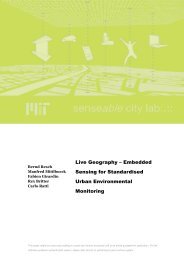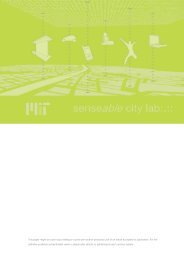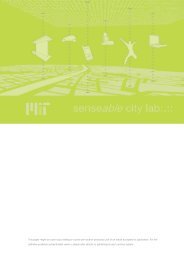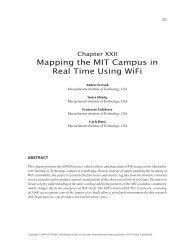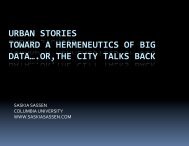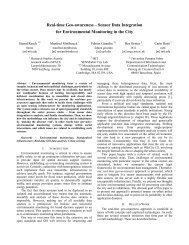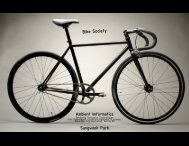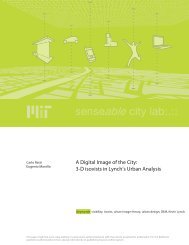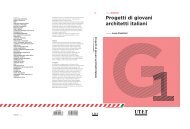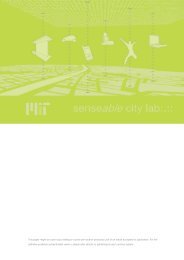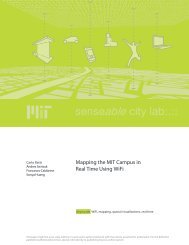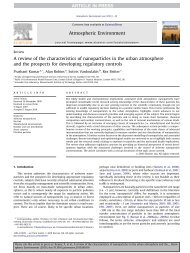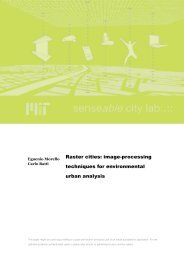Today - MIT SENSEable City Lab
Today - MIT SENSEable City Lab
Today - MIT SENSEable City Lab
You also want an ePaper? Increase the reach of your titles
YUMPU automatically turns print PDFs into web optimized ePapers that Google loves.
User-Generated Content<br />
Figure 3. Geovisualiation of the main<br />
paths taken by photographers between<br />
points of interests in Rome. Significantly,<br />
(a) the 753 visiting Italian photographers<br />
are active across many areas of the city,<br />
whereas (b) the 675 American visitors stay<br />
on a narrow path between the Vatican,<br />
Forum, and Colosseum. (Different scales<br />
apply to each geovisualization.)<br />
(a)<br />
(b)<br />
Figure 4. Geovisualization of the areas defined by the position of the 2,886 photos<br />
with the tag “ruins” as uploaded by 260 photographers. It reveals the Colosseum<br />
and Forum areas known for their multitude of ancient ruins.<br />
footprints to reveal patterns of mobility<br />
and preference among different visitor<br />
groups. However, in the context of our<br />
study, traditional methods would help<br />
us better define the usefulness of pervasive<br />
user-generated content. For example,<br />
hotel occupancy and museum surveys<br />
would let us observe and quantify<br />
visitors’ presence and movement. Along<br />
this vein, the Rome tourism office supplied<br />
us with monthly ticket receipts for<br />
the Colosseum in 2006.<br />
Figure 5 compares sales figures with<br />
mobile usage and photographic activity.<br />
Ticket receipts show that there are<br />
slightly more Colosseum visitors in<br />
October than September, with a major<br />
drop in attendance in November.<br />
This pattern matches the activity of<br />
foreign-registered mobile phones in<br />
the area, but it doesn’t coincide with<br />
photographer activity. These discrepancies<br />
likely exist because the data sets<br />
are capturing the activity of different<br />
sets of visitors. For example, correlation<br />
with ticket sales from the Colosseum<br />
fails to account for the fact that<br />
users can easily photograph the arena<br />
or make a call from the vicinity of the<br />
monument without bothering to pay<br />
the entry fee. Due to the large difference<br />
in the nature of the activity producing<br />
the data, it might be that correlating<br />
it with user-generated content<br />
doesn’t reinforce existing tourism and<br />
travel knowledge but does reveal new<br />
dimensions of behavior.<br />
Significance<br />
of User-Generated Data<br />
These aggregate spatiotemporal records<br />
seem to lead to an improved understanding<br />
of different aspects of mobility<br />
and travel. Although the results are still<br />
fairly coarse, we’ve shown the potential<br />
for geographically referenced digital<br />
Challenges<br />
of User-Generated Data Sets<br />
Our data-processing techniques have<br />
tried to account for the fluctuating<br />
40 PERVASIVE computing www.computer.org/pervasive<br />
Authorized licensed use limited to: IEEE Xplore. Downloaded on December 4, 2008 at 08:13 from IEEE Xplore. Restrictions apply.



